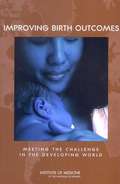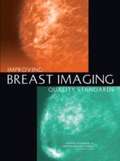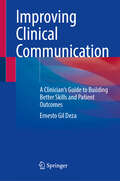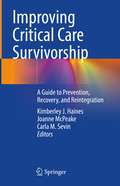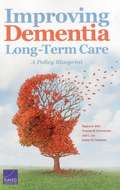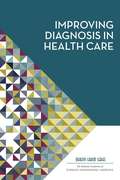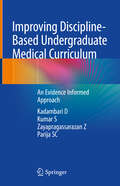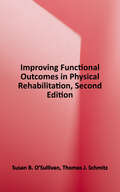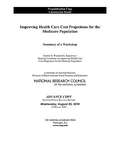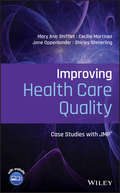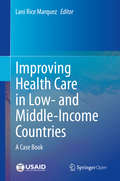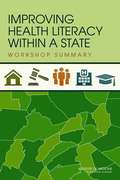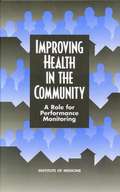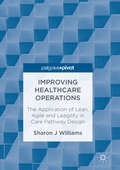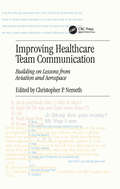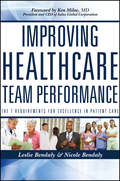- Table View
- List View
Improving Birth Outcomes: Meeting The Challenge In The Developing World
by Committee on Improving Birth OutcomesBirth outcomes have improved dramatically worldwide in the past 40 years. Yet there is still a large gap between the outcomes in developing and developed countries. This book addresses the steps needed to reduce that gap. It reviews the available statistics of low birth weight, prematurity, and birth defects; reviews current knowledge and practices of a healthy pregnancy, identifies cost-effective opportunities for improving birth outcomes and supporting families with an infant handicapped by birth problems, and recommens priority research, capacity building, and institutional and global efforts to reduce adverse birth outcomes in developing countries. The committee has based its study on data and information from several developing countries, and provides recommendations that can assist the March of Dimes, Centers for Disease Control and Prevention, and NIH in tailoring their international program and forging new partnerships to reduce the mortality and morbidity associated with adverse birth outcomes.
Improving Breast Imaging Quality Standards
by Institute of Medicine National Research Council of the National AcademiesMammography is an important tool for detecting breast cancer at an early stage. When coupled with appropriate treatment, early detection can reduce breast cancer mortality. At the request of Congress, the Food and Drug Administration (FDA) commissioned a study to examine the current practice of mammography and breast cancer detection, with a focus on the FDA’s oversight via the Mammography Quality Standards Act (MQSA), to identify areas in need of improvement. Enacted in 1993, MQSA provides a general framework for ensuring national quality standards in facilities performing screening mammography, requires that each mammography facility be accredited and certified, and mandates that facilities will undergo annual inspections. This book recommends strategies for achieving continued progress in assuring mammography quality, including changes to MQSA regulation, as well as approaches that do not fall within the purview of MQSA. Specifically, this book provides recommendations aimed at improving mammography interpretation; revising MQSA regulations, inspections, and enforcement; ensuring an adequate workforce for breast cancer screening and diagnosis; and improving breast imaging quality beyond mammography.
Improving Clinical Communication: A Clinician's Guide to Building Better Skills and Patient Outcomes
by Ernesto Gil DezaThis is a book about medical communication. Communication is a skill, as such it is learnable and can be refined. Between what we learn in college and clinical practice there is a gap regarding communication with patients and their families that many health professionals want to fill. Thus, the goal of this book is to encourage readers to develop their communication skills in patient care. Chapters cover the possible therapeutic origin of the human word, the placebo effect of the medical word, the distinction between information and communication, and the importance of empathy while communicating with patients. An overview of the medical words throughout history up to our current practice is presented. In addition, the content helps to develop a strategy for nonverbal communication and to analyse the impact of empathy on communication and patient satisfaction. Current topics such as special needs for LGBTQ patient care, telehealth and virtual communication are also featured in this book. Knowing how to communicate is healthy not only for the patient but also for the doctor. Therefore, the prevention of medical burnout through adequate communication, both in routine practice, and with patients with special needs, as well as in telemedicine is also discussed. Finally, the author addresses a personal and non-transferable task: each individual must build their own toolbox for communication - the stories, the anecdotes, the metaphors, the silences with which each of the readers will use to communicate with their patients. The aim of this book is to bridge a gap between the graduate and postgraduate training for dealing with information and problems in communicating during clinical practice. Since it is never too late to acquire or improve our communication skills, this work will be a useful and valuable resource for any health professional interested in the subject.
Improving Concentration: A Professional Resource for Assessing and Improving Concentration and Performance
by Roy BaileyImproving Concentration has been designed to help individuals improve their concentration skills. It is aimed primarily at those taking on a training role in relation to the individual concerned. However, it can also be used by the individuals themselves as a self-help resource. This resource will help trainers to convey to their students: an understanding of concentration how concentration works for them how to improve their concentration skills how to manage concentration in relation to their performance. This Psychological skills training resource is arranged in a format that is both easy to use and clear to follow. The activities can be used with both individual students and groups Part 1 'The knowledge base' outlines theoretical perspectives on concentration and describes the Bailey / Brown model of concentration. Part 2 'Pathways to improving concentration' explains and describes how the Bailey / Brown model of concentration can be used as a guide to raising awareness, understanding, monitoring and evaluating interventions aimed at improving concentration in people. Part 3 'The activities' in this resource can be used singly or combined as part of a structured intervention to improve an individual's concentration skills.
Improving Critical Care Survivorship: A Guide to Prevention, Recovery, and Reintegration
by Kimberley J. Haines Joanne McPeake Carla M. SevinThis book provides a comprehensive overview of improving critical care survivorship. Comprised of four sections, the text presents interventions that can be used to improve patient outcomes and reduce the burden of post-intensive care syndrome across the arc of care, from the ICU to returning home. The first section of the text focuses on preventing adverse outcomes in the ICU, with an emphasis on implementing early mobilization, engaging and supporting families, and employing various forms of therapy. The second section revolves around enhancing recovery post-ICU, focusing on physical and neurocognitive rehabilitation programs, peer support, and poly-pharmacy management. Community reintegration is the subject of the third section, with emphasis on socioeconomic reintegration, healthcare utilization, and volunteerism in ICU recovery. The book concludes with a section on future considerations, specifically spotlighting preliminary ideas that address long-term sequelae and international collaboration to solve critical care challenges. Written by experts in the field, Improving Critical Care Survivorship: A Guide for Prevention, Recovery, and Reintegration is a valuable resource for critical care clinicians and researchers interested in improving the quality of patient survival after ICU admission.
Improving Dementia Long-Term Care: A Policy Blueprint
by Regina A. Shih Jodi L. Liu Thomas W. Concannon Esther M. FriedmanIn 2010, 15 percent of Americans older than age 70 had dementia. By 2050, the number of new dementia cases among those 65 and older is expected to double. This blueprint outlines policy options to help decisionmakers improve dementia long-term services and supports (LTSS) by promoting earlier detection, improving access to LTSS, promoting person- and caregiver-centered care, supporting caregivers, and reducing dementia LTSS costs.
Improving Diagnosis in Health Care
by Erin P. BaloghGetting the right diagnosis is a key aspect of health care - it provides an explanation of a patient's health problem and informs subsequent health care decisions. The diagnostic process is a complex, collaborative activity that involves clinical reasoning and information gathering to determine a patient's health problem. According to Improving Diagnosis in Health Care, diagnostic errors-inaccurate or delayed diagnoses-persist throughout all settings of care and continue to harm an unacceptable number of patients. It is likely that most people will experience at least one diagnostic error in their lifetime, sometimes with devastating consequences. Diagnostic errors may cause harm to patients by preventing or delaying appropriate treatment, providing unnecessary or harmful treatment, or resulting in psychological or financial repercussions. The committee concluded that improving the diagnostic process is not only possible, but also represents a moral, professional, and public health imperative. "Improving Diagnosis in Health Care" a continuation of the landmark Institute of Medicine reports "To Err Is Human" (2000) and "Crossing the Quality Chasm" (2001) finds that diagnosis-and, in particular, the occurrence of diagnostic errorsa "has been largely unappreciated in efforts to improve the quality and safety of health care. Without a dedicated focus on improving diagnosis, diagnostic errors will likely worsen as the delivery of health care and the diagnostic process continue to increase in complexity. Just as the diagnostic process is a collaborative activity, improving diagnosis will require collaboration and a widespread commitment to change among health care professionals, health care organizations, patients and their families, researchers, and policy makers. The recommendations of "Improving Diagnosis in Health Care" contribute to the growing momentum for change in this crucial area of health care quality and safety. "
Improving Diets and Nutrition
by Brian Thompson Leslie AmorosoNutrition-sensitive, food-based approaches towards hunger and malnutrition are effective, sustainable and long-term solutions. This book discusses the policy, strategic, methodological, technical and programmatic issues associated with such approaches, proposes "best practices" for the design, targeting, implementation and evaluation of specific nutrition-sensitive, food-based interventions and for improved methodologies for evaluating their efficacy and cost-effectiveness, and provides practical lessons for advancing nutrition-sensitive food-based approaches for improving nutrition at policy and programme level.
Improving Diets and Nutrition: Food-based Approaches (Co-published With The Food And Agriculture Organization Of The United Nations (fao) Ser.)
by Brian Thompson Leslie AmorosoNutrition-sensitive, food-based approaches towards hunger and malnutrition are effective, sustainable and long-term solutions. This book discusses the policy, strategic, methodological, technical and programmatic issues associated with such approaches, proposes “best practices” for the design, targeting, implementation and evaluation of specific nutrition-sensitive, food-based interventions and for improved methodologies for evaluating their efficacy and cost-effectiveness, and provides practical lessons for advancing nutrition-sensitive food-based approaches for improving nutrition at policy and programme level.
Improving Discipline-Based Undergraduate Medical Curriculum: An Evidence Informed Approach
by Kadambari D Kumar S Zayapragassarazan Z Parija ScThe past few decades have seen the increasing use of evidence in all aspects of healthcare. The concept of evidence-informed healthcare began in the 1990s as evidence-informed practice, and has since become widely accepted. It is also accepted that the training of medical graduates must be informed by evidence obtained from educational research. This book utilizes an evidence-informed approach to improve discipline-based undergraduate medical curricula. Discipline-based undergraduate medical curricula represent a widely adopted choice for undergraduate medical education around the world. However, there have been criticisms leveled against the discipline-based approach. One of the shortcomings cited is that students are insufficiently equipped to meet the challenges of today’s healthcare. As a result, various strategies have been proposed. One option, currently in vogue, is the outcome-based approach, wherein the exit behaviors of medical graduates are explicitly examined and used to guide the educational process. The shortcomings present in discipline-based undergraduate medical curricula can be overcome by the strengths of these strategies. This book recommends improving discipline-based undergraduate medical curricula by combining several strategies, including the adoption of an outcome-based approach and the use of evidence-informed implementable solutions. The book is relevant for all faculty, administrators and policymakers involved in undergraduate medical education, and can also be used as a resource for faculty development.
Improving Effective Coverage in Health: Do Financial Incentives Work? (Policy Research Reports)
by Friedman Adam Wagstaff Damien de Walque Eeshani Kandpal Moritz Piatti-Fünfkirchen Anja Sautmann Gil Shapira Ellen Van de PoelIn many low- and middle-income countries, health coverage has improved dramatically in the past two decades, but health outcomes have not. As such, effective coverage—a measure of service delivery that meets a minimum standard of quality—remains unacceptably low. Improving Effective Coverage in Health examines one specific policy approach to improving effective coverage: financial incentives in the form of performance-based financing (PBF), a package reform that typically includes performance pay to frontline health workers as well as facility autonomy, transparency, and community engagement. This Policy Research Report draws on a rich set of rigorous studies and new analysis. When compared with business-as-usual, in low-income settings with centralized health systems PBF can result in substantial gains in effective coverage. However, the relative benefits of PBF—the performance pay component in particular—are less clear when it is compared with two alternative approaches, direct facility financing, which provides operating budgets to frontline health services with facility autonomy on allocation, but not performance pay, and demand-side financial support for health services (that is, conditional cash transfers and vouchers). Although PBF often results in improvements on the margins, closing the substantial gaps in effective health coverage is not yet within reach for many countries. Nonetheless, important lessons and experiences from the rollout of PBF over the past decade can guide health financing into the future. In particular, to be successful, health financing reform may need to pivot from performance pay while retaining the elements of direct facility financing, autonomy, transparency, and community engagement.
Improving Effective Coverage in Health: Do Financial Incentives Work? (Policy Research Reports)
by Friedman Adam Wagstaff Damien de Walque Eeshani Kandpal Moritz Piatti-Fünfkirchen Anja Sautmann Gil Shapira Ellen Van de PoelIn many low- and middle-income countries, health coverage has improved dramatically in the past two decades, but health outcomes have not. As such, effective coverage--a measure of service delivery that meets a minimum standard of quality--remains unacceptably low. 'Improving Effective Coverage in Health' examines one specific policy approach to improving effective coverage: financial incentives in the form of performance-based financing (PBF), a package reform that typically includes performance pay to frontline health workers as well as facility autonomy, transparency, and community engagement. This Policy Research Report draws on a rich set of rigorous studies and new analysis. When compared with business-as-usual, in low-income settings with centralized health systems PBF can result in substantial gains in effective coverage. However, the relative benefits of PBF--the performance pay component in particular--are less clear when it is compared with two alternative approaches, direct facility financing, which provides operating budgets to frontline health services with facility autonomy on allocation, but not performance pay, and demand-side financial support for health services (that is, conditional cash transfers and vouchers). Although PBF often results in improvements on the margins, closing the substantial gaps in effective health coverage is not yet within reach for many countries. Nonetheless, important lessons and experiences from the rollout of PBF over the past decade can guide health financing into the future. In particular, to be successful, health financing reform may need to pivot from performance pay while retaining the elements of direct facility financing, autonomy, transparency, and community engagement.
Improving Food Safety Through a One Health Approach
by Eileen R. ChoffnesGlobalization of the food supply has created conditions favorable for the emergence, reemergence, and spread of food-borne pathogens-compounding the challenge of anticipating, detecting, and effectively responding to food-borne threats to health. In the United States, food-borne agents affect 1 out of 6 individuals and cause approximately 48 million illnesses, 128,000 hospitalizations, and 3,000 deaths each year. This figure likely represents just the tip of the iceberg, because it fails to account for the broad array of food-borne illnesses or for their wide-ranging repercussions for consumers, government, and the food industry-both domestically and internationally. A One Health approach to food safety may hold the promise of harnessing and integrating the expertise and resources from across the spectrum of multiple health domains including the human and veterinary medical and plant pathology communities with those of the wildlife and aquatic health and ecology communities. The IOM's Forum on Microbial Threats hosted a public workshop on December 13 and 14, 2011 that examined issues critical to the protection of the nation's food supply. The workshop explored existing knowledge and unanswered questions on the nature and extent of food-borne threats to health. Participants discussed the globalization of the U. S. food supply and the burden of illness associated with foodborne threats to health; considered the spectrum of food-borne threats as well as illustrative case studies; reviewed existing research, policies, and practices to prevent and mitigate foodborne threats; and, identified opportunities to reduce future threats to the nation's food supply through the use of a "One Health" approach to food safety. Improving Food Safety Through a One Health Approach: Workshop Summary covers the events of the workshop and explains the recommendations for future related workshops.
Improving Functional Outcomes in Physical Rehabilitation
by Susan B. O'Sullivan Thomas J. SchmitzAchieve the best functional outcomes for your patients. Here is a practical, step-by-step guide to understanding the treatment process and selecting the most appropriate intervention for your patient. Superbly illustrated, in-depth coverage shows you how to identify functional deficits, determine what treatments are appropriate, and then implement them to achieve the best functional outcome for your patients. This one-of-a-kind resource features case studies in the text accompanied by videos online at DavisPlus that demonstrate how the interventions selected make a difference in your patients’ lives.
Improving Health Care Cost Projections for the Medicare Population: Summary of a Workshop
by National Research Council of the National AcademiesDeveloping credible short-term and long-term projections of Medicare health care costs is critical for public- and private-sector policy planning, but faces challenges and uncertainties. There is uncertainty not only in the underlying economic and demographic assumptions used in projection models, but also in what a policy modeler assumes about future changes in the health status of the population and the factors affecting health status , the extent and pace of scientific and technological breakthroughs in medical care, the preferences of the population for particular kinds of care, the likelihood that policy makers will alter current law and regulations, and how each of these factors relates to health care costs for the elderly population. Given the substantial growth in the Medicare population and the continued increases in Medicare, Medicaid, and private health insurance spending, the availability of well-specified models and analyses that can provide useful information on the likely cost implications of health care policy alternatives is essential. It is therefore timely to review the capabilities and limitations of extant health care cost models and to identify areas for research that offer the most promise to improve modeling, not only of current U.S. health care programs, but also of policy alternatives that may be considered in the coming years. The National Research Council conducted a public workshop focusing on areas of research needed to improve health care cost projections for the Medicare population, and on the strengths and weaknesses of competing frameworks for projecting health care expenditures for the elderly. The workshop considered major classes of projection and simulation models that are currently used and the underlying data sources and research inputs for these models. It also explored areas in which additional research and data are needed to inform model development and health care policy analysis more broadly. The workshop, summarized in this volume, drew people from a wide variety of disciplines and perspectives, including federal agencies, academia, and nongovernmental organizations.
Improving Health Care Quality: Case Studies with JMP
by Cecilia Martinez Mary Ann Shifflet Oppenlander ShmerlingLearn how to improve the quality of health care offered by your institution using data you already have Improving Health Care Quality: Case Studies with JMP® teaches readers how to systematically identify problems, collect and interpret data, and solve issues in the real world. Relying on JMP® software, the authors walk readers through the process of applying quality improvement techniques to real-life health care problems. The case studies provided in the book vary significantly and provide a wide-ranging view of the application of quality improvement techniques in the health care field. Studies regarding length of stay of diabetes patients to benchmarking the costs of hip replacement all serve to illuminate and explain the underlying concepts of statistical analysis. The authors break each case study down into several sections, including: Background and Task Data and Data Management Analysis Summary Concepts and Tools Exercises and Discussion Questions Each section reinforces the lessons learned in each case study and helps the reader learn to apply statistical data to their own health care quality problems.
Improving Health Care Safety and Quality: Reluctant Regulators (Law, Ethics and Governance)
by Judith HealyResponding to the public concern caused by recent hospital scandals and accounts of unintended harm to patients, this author draws on her experience of analysing the health care systems of over a dozen countries and examines whether greater regulation has increased patient safety and health care quality. The book adopts a new approach to mapping developments in health care systems in Europe, North America and Australia and pieces together evidence of which regulatory strategies and mechanisms work well to ensure safer patient care. It identifies the regulatory bodies, the regulatory principles and the implementation strategies adopted to improve governance in health care systems and suggests a conceptual framework for responsive regulation. The book will be of interest to government actors, health care professionals and medico-legal scholars.
Improving Health Care in Low- and Middle-Income Countries: A Case Book
by Lani Rice MarquezThis open access book is a collection of 12 case studies capturing decades of experience improving health care and outcomes in low- and middle-income countries. Each case study is written by healthcare managers and providers who have implemented health improvement projects using quality improvement methodology, with analysis from global health experts on the practical application of improvement methods. The book shows how frontline providers in health and social services can identify gaps in care, propose changes to address those gaps, and test the effectiveness of their changes in order to improve health processes and outcomes. The chapters feature cases that provide real-life examples of the challenges, solutions, and benefits of improving healthcare quality and clearly demonstrate for readers what quality improvement looks like in practice:Addressing Behavior Change in Maternal, Neonatal, and Child Health with Quality Improvement and Collaborative Learning Methods in GuatemalaHaiti’s National HIV Quality Management Program and the Implementation of an Electronic Medical Record to Drive Improvement in Patient CareScaling Up a Quality Improvement Initiative: Lessons from Chamba District, IndiaPromoting Rational Use of Antibiotics in the Kyrgyz RepublicStrengthening Services for Most Vulnerable Children through Quality Improvement Approaches in a Community Setting: The Case of Bagamoyo District, TanzaniaImproving HIV Counselling and Testing in Tuberculosis Service Delivery in Ukraine: Profile of a Pilot Quality Improvement Team and Its Scale‐Up JourneyImproving Health Care in Low- and Middle-Income Countries: A Case Book will find an engaged audience among healthcare providers and administrators implementing and managing improvement projects at Ministries of Health in low- to middle-income countries. The book also aims to be a useful reference for government donor agencies, their implementing partners, and other high-level decision makers, and can be used as a course text in schools of public health, public policy, medicine, and development.ACKNOWLEDGMENT:This work was conducted under the USAID Applying Science to Strengthen and Improve Systems (ASSIST) Project, USAID Award No. AID-OAA-A-12-00101, which is made possible by the generous support of the American people through the U.S. Agency for International Development (USAID).DISCLAIMER:The contents of this book are the sole responsibility of the Editor(s) and do not necessarily reflect the views of USAID or the United States Government.^
Improving Health Care of the Poor: The New York City Experience
by Miriam OstowFirst Published in 2018. Routledge is an imprint of Taylor & Francis, an Informa company.
Improving Health Literacy Within a State: Workshop Summary
by The National Academy of SciencesHealth literacy is the degree to which individuals can obtain, process, and understand the basic health information and services they need to make appropriate health decisions. According to Health Literacy: A Prescription to End Confusion(IOM, 2004), nearly half of all American adults--90 million people--have inadequate health literacy to navigate the healthcare system. To address issues raised in that report, the Institute of Medicine convened the Roundtable on Health Literacy, which brings together leaders from the federal government, foundations, health plans, associations, and private companies to discuss challenges facing health literacy practice and research and to identify approaches to promote health literacy in both the public and private sectors. On November 30, 2010, the roundtable cosponsored a workshop with the University of California, Los Angeles (UCLA), Anderson School of Management in Los Angeles. Improving Health Literacy Within a Stateserves as a summary of what occurred at the workshop. The workshop focused on understanding what works to improve health literacy across a state, including how various stakeholders have a role in improving health literacy. The focus of the workshop was on presentations and discussions that address (1) the clinical impacts of health literacy improvement approaches; (2) economic outcomes of health literacy implementation; and (3) how various stakeholders can affect health literacy.
Improving Health in the Community: A Role for Performance Monitoring
by Committee on Using Performance Monitoring to Improve Community HealthHow do communities protect and improve the health of their populations? Health care is part of the answer but so are environmental protections, social and educational services, adequate nutrition, and a host of other activities.With concern over funding constraints, making sure such activities are efficient and effective is becoming a high priority.Improving Health in the Community explains how population-based performance monitoring programs can help communities point their efforts in the right direction.Within a broad definition of community health, the committee addresses factors surrounding the implementation of performance monitoring and explores the "why" and "how to" of establishing mechanisms to monitor the performance of those who can influence community health. The book offers a policy framework, applies a multidimensional model of the determinants of health, and provides sets of prototype performance indicators for specific health issues.Improving Health in the Community presents an attainable vision of a process that can achieve community-wide health benefits.
Improving Healthcare Operations
by Sharon J WilliamsThis book examines the design of two care pathways to establish how key principles associated with systems thinking, quality improvement, and supply chain management can improve the design of these services. 'Lean' has typically been the prominent approach when improving the design of healthcare systems and is often selected by healthcare professionals to standardize and improve the delivery of care. Previous literature shows there has been varying success in the application of 'Lean', the author presents a study which examines the benefits of introducing 'Agile' as an alternative and complementary approach. Improving Healthcare Operations explores when 'Lean' and 'Agile' are most applicable, and instances where a hybrid approach can be employed. Including empirical qualitative data collected from two care pathways, it intends to provide organizations with an alternative in order to produce the level and quality of care that is expected by patients.
Improving Healthcare Services: Coproduction, Codesign and Operations
by Sharon J. Williams Lynne CaleyBuilding on co-author Sharon Williams’ previous title Improving Healthcare Operations, this book examines the role of co-design and coproduction in health and social care. Extending current thinking on coproduction in healthcare and how this can be operationalised, this book opens a discussion around how it can contribute to improvement. Providing a number of case studies, it links previous public service management, operations management and supply chain management research by extending and translating these core design and improvement principles into health and social care. Considering the wider role of patients, communities and other stakeholders it will challenge and develop existing thinking in relation to co-design, coproduction and redesign of services.
Improving Healthcare Team Communication: Building on Lessons from Aviation and Aerospace
by Christopher P. NemethCommunications research in aviation is widely regarded by many in the healthcare community as the 'gold standard' to emulate. Yet healthcare and aviation differ in many ways, as do the vital communications shared among members of clinical teams. Aviation team communication should, then, be understood in terms of what lessons will benefit those who work in healthcare. In Improving Healthcare Team Communication, renowned experts provide insights from 'sharp end' operator research in high-hazard sectors that shed light on the performance of cognitive tasks including resource availability assessment, allocation, anticipation, prediction, trade-off decisions, speculation and negotiation. The book reports on recent field research to address what is known, and what needs to be learned, about team communication among operators. Students, clinicians and healthcare managers can find answers in it to the questions they face daily. How can healthcare information be better shared? What can we expect from its improvement, and how do we get there? Lessons learned from team communication research and experience in aviation and healthcare will point the way to improved patient safety.
Improving Healthcare Team Performance
by Leslie Bendaly Nicole BendalyPractical, proven techniques for improving team performance in the health care worldTeams and collaboration have become an expectation in most healthcare facilities and environments. It is accepted that high performance, patient focused teams are critical to quality patient care. However, there is often a wide gap between traditional practices and the new behaviours and practices required for teamwork and collaboration. Improving Health Care Team Performance goes beyond theory to provide the knowledge, tools, and techniques required to develop a single team, or to develop an organization wide team based culture, from which exceptional patient care emerges.Most uniquely it emphasizes that effective teamwork goes far beyond team dynamics and provides detailed description of additional requirements, such as shared learning and change compatibility, and how to fulfill them.A practical handbook for healthcare leaders striving to ensure a superior patient experience and high quality of care, Improving Healthcare Team Performance not only provides specifics on how to develop high functioning teams, whether multidisciplinary, interdisciplinary, or departmental but also offers those dealing with the common healthcare leadership challenges of low morale, poor communication, interpersonal conflict, and lack of knowledge sharing the tools to take immediate action to improve performance. Providing a proven approach to addressing and preventing everyday issues impacting patient care, Improving Health Care Team Performance contains everything needed to identify areas of greatest need within a team or department, take targeted action to address key gaps, and measure progress towards positive change.Presents a clear depiction of what constitutes collaboration and a high-performing patient focused team. This includes the skills and practices required to improve team performance and ultimately the quality of patient care, how to develop new attitudes and behaviours within the team, as well as the leadership requirements for success in a patient focused, team based culture.Provides a set of development tools accessible online to help the reader quickly and easily apply the knowledge gleaned.Offers targeted solutions including tips/recommendations, a step-by-step approach for affecting necessary change at every level of the organization, and skills and team development activities.Designed for leaders working in any healthcare environment, Improving Health Care Team Performance is a practical approach to improving team performance and the quality of patient care.
